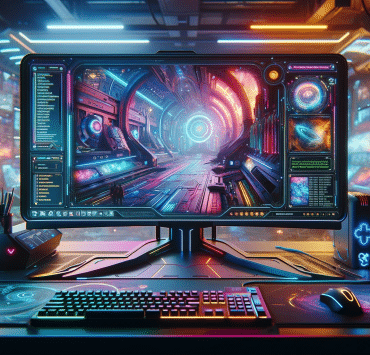AI Product Developer
2024 brings us the promise of production-level AI as global digital outfits such as Google, Salesforce, and Microsoft aim to achieve something close to Artificial General Intelligence or AGI. Digital assistants, for instance, could go from automated schedulers to business strategists, making analyst jobs irrelevant and creating uncertainty among digital workers. The surge of AI-powered apps and platforms follows the advancements in generative AI in 2023 spurred by massive investments such as Microsoft’s $10 billion funding of OpenAI and Amazon’s $4 billion backing of Anthropic,
Silicon Valley giants are placing huge bets, and they’re not the only ones making moves. The thriving Artificial Intelligence industry led governments to implement regulations in 2023, with the European Union introducing detailed AI policies and the U.S. Biden Administration issuing a comprehensive Executive Order. Amidst this brand-new AI landscape, speculation intensifies on what’s to come for AI in 2024. While fun to muse on, many leave us wondering if AI is just another hype cycle.
AI will trigger workplace transformation
The workforce in 2024 will undergo a substantial and vital transformation as AI becomes valuable and accessible to workers and signals a fundamental change in organizational structures.
Creatives, lawyers, engineers, and finance experts increasingly integrate AI into their workflows. This integration alters job roles as AI takes over specific tasks, enhancing efficiency and fostering innovative approaches. For example, Wells Fargo and KeyBank use Google Cloud AI to provide a more customized, effortless, and straightforward banking experience. A further article from PwC outlines a range of strategies for lawyers to incorporate AI into their daily tasks, reflecting the growing need for legal professionals to embrace AI in their routine tasks.
IBM’s AI Solutions, with their IBM WatsonX assistants, provides customer support using AI. WatsonX Orchestrate manages candidates and existing employees, reducing the workload and freeing human cycles. Finally, WatsonX Code Assistant speeds up code generation, increases developer productivity, reduces coding complexity, and accelerates developer onboarding.
How AI is Reshaping Creativity
Deepfakes are a significant topic, especially with the advancements in generative AI models. These developments have enabled the creation of highly realistic audio and video content. While some have unfortunately used this technology to spread misinformation, it also holds potential for creative and approving applications. For example, deepfake technology animates famous artworks, such as Leonardo Da Vinci’s Mona Lisa, adding a new dimension to art engagement.
In another instance, Gen Studio, a collaboration between MIT, Microsoft, and the Metropolitan Museum of Art, leverages deepfake technology for artistic creation, allowing users to generate unique artworks. The Salvador Dalí Museum has also utilized deepfakes to digitally reanimate Salvador Dalí, offering an interactive experience for visitors.
In response to the potential for misuse of deepfake technology, particularly in spreading misinformation, existing AI software stacks such as AWS, Microsoft Azure, and IBM have developed robust tools for cybersecurity. AWS, at its re:Invent 2023 event, launched new GenAI products, including advanced cybersecurity solutions for its platform, signifying a commitment to combating complex cyber threats. Microsoft Azure has expanded its security solutions with AI integration, notably introducing the Security Copilot for enhanced threat detection and response. IBM has also unveiled AI-powered threat detection and response services, emphasizing accelerated security responses and comprehensive protection.
AI Agents Pioneering the Future of Autonomous Customer Service
AI agents, a highly anticipated development since the inception of ChatGPT, are poised to revolutionize user interaction in 2024. The early versions, such as AutoGPT, allowed users to assign tasks with retained memory and specialization, paving the way for more sophisticated applications. Despite their initial helpfulness, these early agents didn’t capture widespread attention, often being too complex for the average user or too similar to existing GPT tools.
In a significant move, last January, OpenAI launched its GPT store, aiming to resolve these issues and enable the creation of specialized agents for everyday tasks. This store empowers users to design their own GPT agents, inputting specific data like PDFs and tailoring them with distinct instructions. Currently, users can explore hundreds of GPTs, both user-created and developed by OpenAI, by accessing the GPT store with a Plus, Enterprise, or Team account.
In the customer service domain, these AI agents are set to transform how businesses interact with their customers. With the ability to understand and respond to customer queries in a more personalized and efficient manner, AI agents can greatly enhance the customer service experience. They are capable of providing instant responses, reducing wait times, and handling a higher volume of queries without compromising the quality of service.
This improves customer satisfaction and allows human customer service representatives to focus on more complex and nuanced issues, where human empathy and expertise are crucial. Companies like Apple and Amazon, known for their AI assistants Siri and Alexa, are also exploring ways to integrate these advanced AI technologies into their customer service models. Meanwhile, research initiatives, such as MIT’s recent work on using LLMs for more intuitive AI explanations, hint at an even more sophisticated future for AI agents in customer service, where they could potentially understand and address customer needs with unprecedented accuracy and nuance.
Developers Tackle AI’s GPU Supply Gap
As AI becomes increasingly prevalent, it’s sparking a significant surge in the demand for hardware, particularly GPUs. This growing necessity stems from companies vigorously integrating AI services and products into their existing offerings, which in turn amplifies the need for powerful GPUs to efficiently run these complex models. Consequently, this escalating demand risks leading to GPU shortages, placing considerable pressure on manufacturers like Nvidia.
Should these shortages materialize, a likely outcome could be a hike in GPU prices. This potential increase in costs poses a particular challenge for companies and countries operating on limited budgets. While emerging technologies promise to alleviate this shortage, their current unavailability only adds to the urgency. This situation emphasizes the need for research labs to expedite the development of alternative solutions. The relentless march of AI, while a hallmark of progress, also highlights the delicate balance between technological advancement and resource availability.
Lessons from the Crypto Market
Throughout 2023, a multitude of AI applications emerged, yet it’s likely that not all will withstand the test of time. Users tend to gravitate towards well-established AI tools that not only show a clear path of evolution but also provide reliable roadmaps for future development, often leaving behind those less effective. This trend somewhat mirrors the dynamics observed in the crypto bull market, where a myriad of cryptocurrencies soared initially, only to eventually plummet in value.
In the realm of generative AI, tools like ChatGPT, Bard, Midjourney, and Stable Diffusion have established themselves as frontrunners, consistently attracting more users. However, it’s crucial for specific tools to evolve their AI offerings to avoid fading into obscurity. Concurrently, a significant number of users show a preference for open-source models, suggesting that these models will likely continue to thrive and coexist with the AI giants. This dynamic landscape of AI tools reflects the ever-changing preferences and needs of users in the digital age.
Mapping the Future of AGI
AGI is something that many of us have dreamed of since science fiction movies showed us the responsiveness and easiness of how machines and sentient AI beings coexist with humans. However, as you begin exploring the complexities and subtleties of how AI works, it’s clear that the concept of AGI that most of us had while growing up is challenging to achieve. Nonetheless, this concept is now more apparent to several people worldwide, and it’s safe to say that advancements in LLMs and generative AI are the true beginning of AGI.
Even Altman addressed AGI on X, writing it as a response to a question he asked the public: ‘What would you like OpenAI to build/fix?’ Altman then compiled his favorite responses, and AGI was at the top of the list. He also wrote, in parentheses, ‘(a little patience, please),’ indicating that AGI is a complex concept but achievable. With all these developments, multimodal models are ready to flourish, and 2024 could be the year where AI agents advance to perform advanced tasks. Likewise, companies will likely integrate these new AI models into robots and hardware systems, edging us closer to the advent of Artificial General Intelligence (AGI).
If you are looking to leverage AI software stacks to begin exploring new AI tools and possibly contribute to the early stages of AGI, consider the opportunities beyond the familiar giants of AWS, IBM, and Microsoft. H2O.ai stands out with its open-source generative AI capabilities and large language models, recognized for its visionary approach to predictive modeling.
Alibaba Cloud AI Services has responded to the growing demand for Generative AI with innovative products like their latest large language model, Tongyi Qianwen. Baidu ML leads China’s AI Cloud market, expanding its ERNIE Bot and introducing the advanced LLM Ernie 4.0. Tencent AI, demonstrating the trend towards omnipresent AI, integrates its model across 180 services and offers tools like Hyper Application Inventor for streamlined AI application development. Clarifai provides a comprehensive full-stack AI platform, facilitating rapid AI development. Oracle Generative AI, designed for enterprise use, offers customizable large language models and new API-led services, making it easier to incorporate generative AI into applications.














